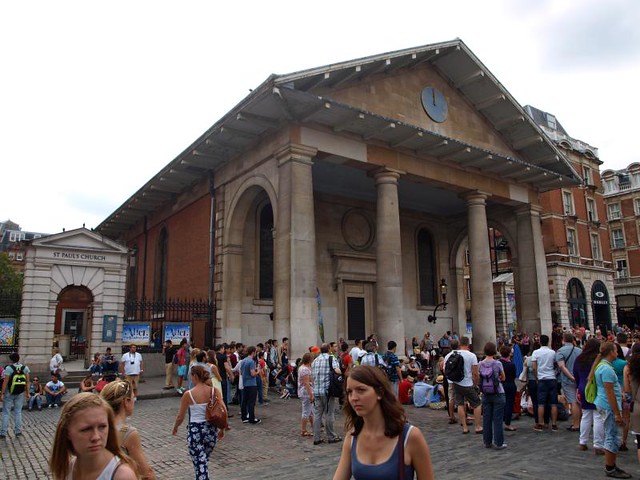The exterior is hard to judge without perambulation but the east end is neoclassical and should be rather grand, if plain, but for the fact that it now plays host to the Covent Garden mummers which somewhat detracts its impact.
Supposedly designed by Inigo Jones in 1633 it was burnt out in 1795 and was effectively rebuilt by Thomas Hardwick (who had restored it in 1789); so I suppose it's therefore a C17th core but a C18th build. Apparently it has a Grinling Gibbons pulpit which would have been interesting to see.
The Earl of Bedford himself noted in his commonplace book: “London the Ring Couengarden the iewell of that ring.” He was clearly proud of his estate, but for all that, he looked carefully at the money he was laying out on the new investment. He was responsible for the church and for perhaps three of the houses on the eastern side, as examples to those who wished to take up building leases. When it came to the church, he sent for Inigo Jones and
told him he wanted a chapel for the parishioners of Covent Garden, but added he would not go to any considerable expense; “In short”, said he, “I would not have it much better than a barn.” “Well! then,” said Jones, “You shall have the handsomest barn in England.”
This story has often been told but it bears repeating for St Paul’s, Covent Garden, does indeed resemble a barn, being very plain, with great over-hanging eaves and a portico before the eastern front, which faced the Piazza, with heavy fluted columns and uncompromisingly plain Tuscan capitals. Inside, the church was equally unadorned, which would have agreed with the earl’s severe religious tenets, but Inigo Jones made one miscalculation. If the entrance portico were to face the Piazza, then it would be necessary to place the altar at the west end. Such a deviation was impermissible; the altar was installed in the accustomed position, the congregation entered by the west door, through the churchyard, and the portico stood in front of a blind wall. It was under this portico that Shaw placed Eliza Doolittle in the first act of Pygmalion. St Paul’s, the first Anglican church to be built in London since Tudor times, cost £4,886. 5s. 8d.
told him he wanted a chapel for the parishioners of Covent Garden, but added he would not go to any considerable expense; “In short”, said he, “I would not have it much better than a barn.” “Well! then,” said Jones, “You shall have the handsomest barn in England.”
This story has often been told but it bears repeating for St Paul’s, Covent Garden, does indeed resemble a barn, being very plain, with great over-hanging eaves and a portico before the eastern front, which faced the Piazza, with heavy fluted columns and uncompromisingly plain Tuscan capitals. Inside, the church was equally unadorned, which would have agreed with the earl’s severe religious tenets, but Inigo Jones made one miscalculation. If the entrance portico were to face the Piazza, then it would be necessary to place the altar at the west end. Such a deviation was impermissible; the altar was installed in the accustomed position, the congregation entered by the west door, through the churchyard, and the portico stood in front of a blind wall. It was under this portico that Shaw placed Eliza Doolittle in the first act of Pygmalion. St Paul’s, the first Anglican church to be built in London since Tudor times, cost £4,886. 5s. 8d.

No comments:
Post a Comment